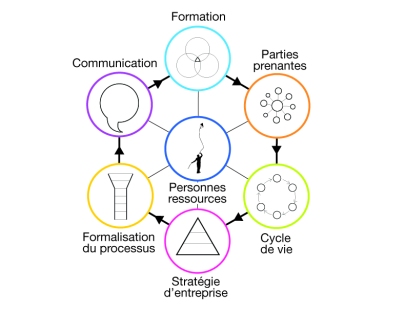Here we are approaching the big conference day. I have been looking over my past presentations and all the work I’ve been doing in the past months. I have found a way to express the knowledge I have gathered while working with companies dealing with their eco-action. These are the 7 elements that I have found in each one of them. Of course, no company is exactly like the other. They all have their own culture and history. But these seven elements find their way into the company’s shift in some way, shape or form.
1) Formation. This is the first touchpoint. Somehow, somewhere, someone got some knowledge. Formation includes all forms of learning, wether from experts giving out their point of view, or from the employe’s findings in the field, or from outsides sources all ready conscientious of the issues at hand. Simply put, someone is spreading the knowledge of what has, is and will happen to the earth. Formation also includes the idea that knowledge is power to change. Knowing what you don’t know is the first step.
2) Interested parties. Why o why would anyone want to change if things aren’t broken? Here’s the new reality. Things are always changing. It’s not a question of don’t change… It’s a question of when are you going to fix it. All companies are in uncertain, changing seas. The wave will hit you at some point. We’re all connected. If one your clients has chosen to be responsible of the environment, that same responsibility will be extended to you. Sometimes, you will have the choice not to follow suit. But at some time, earlier or later, that responsibility will be imposed to you. Getting to know the interested parties around you will allow your company to react appropriately to this wave. Who knows you might be able to surf on it.
3) Life Cycle. This is the life of the output of your company. Whether it be a product, a service or a process, there is a life cycle. It has been born and it will reach an end. The important goal is the cycle of this life. The idea that what what ever has a life will remain invested in the future of its self. From the extraction of the materials, to the production, to the logistics, to the use and the end of life, the impacts of a product’s life cycle can be calculated. This life cycle element is the most objective part of the eco-action. Science is behind the judgement of what is better or worse.
4) Company strategy. Setting goals and ways to fulfill them. To measure indicators and track their evolution. This is the most simple yet most elusive aspect of the process. The company needs to incorporate these elements of environmental successes into its founding mission and vision. Subsequently, the values that will drive these eco-actions towards the sustainable development of the company must figure within the culture of the company. Everyone is inherently implicated in this process. It can be the biggest of team builders because everyone wins when taking care of the environment.
5) Formalization of the process. For eco-projects to take place on a regular basis, a formal integration of the process must take form. In the case of product development, the stage-gate process of a PDP is a great place to establish the role of environmental requirements and to address preoccupations for futur projects. Formalization can also be understood at a human ressources level whereby founding a committee or simply creating a time and space to have a regular conversations will keep the environmental agenda moving around the table.
6) Communication. A company needs to take advantage of the possibilities of communication to show the world their efforts. Also, communication is the only vehicle for information as to what the company has been doing in terms of the environment. A project that has given birth to a more ecologically sound product will never been seen as such if the clients aren’t informed of such. Communication is the window of exchange that needs to be open for people to understand what it is that they are looking at.
7) Resource People. The most valuable asset of any company is the people working within. Without them, there is no company. Without resource people, there is no eco-action. It is the resource people that make it happen. Let it be know that resource people can be found inside and outside the company. Resource people are the ones that bring the expertise required in the formation element, the are the ones listening and interacting with the interested parties, they are the ones studying and reinventing the lifecycle, they are the ones who link the project to the company strategy, they are the ones making sure the process continues, they are the ones communicating the progess.
Those are the seven elements that make ideals a reality. Seven elements that bring on eco-actions.
Filed under: 1














